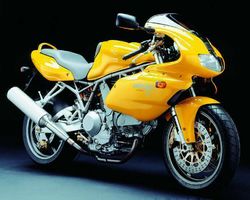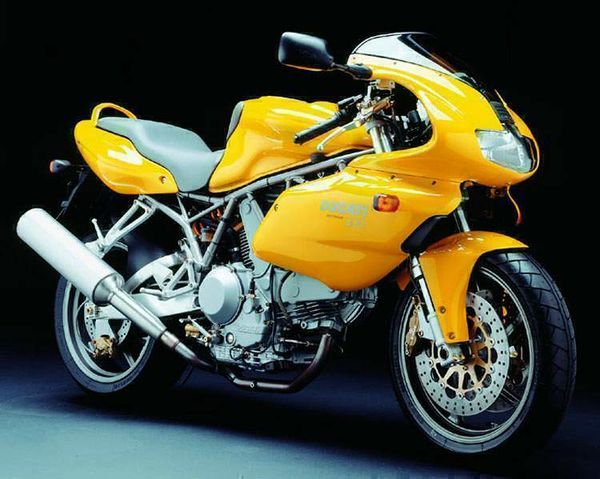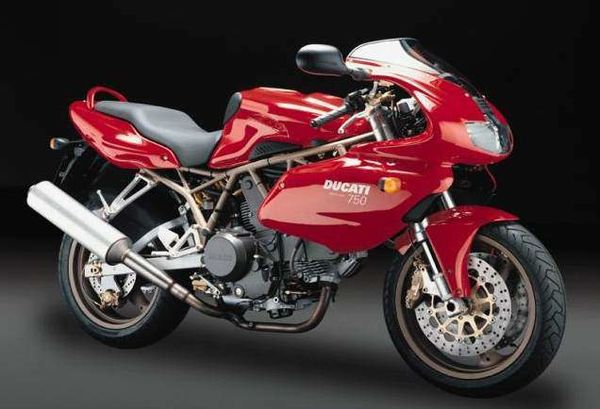Ducati 900SS Half Faird
 |
|
| Ducati 900SS Half Faird | |
| Manufacturer | |
|---|---|
| Production | 1999-00 |
| Engine | Four stroke, 90°Ltwin cylinder, SOHC, desmodromic 2 valve per cylinder, belt driven |
| Compression ratio | 9.2:1 |
| Top Speed | 230.8 km/h / 143.4 mph |
| Ignition | Marelli electronic |
| Spark Plug | Champion RA6HC |
| Battery | 12V 16Ah |
| Transmission | 6 Speed |
| Frame | Tubular Chrome Moly steel trestle |
| Suspension | Front: 43mm Showa GD 131 upside-down forks, preload, compression and rebound adjustable Rear: Showa GD 132 progressive linkage monoshock, preload, compression and rebound adjustable |
| Brakes | Front: 2 x 320 mm Discs, 4 piston calipers Rear: Single 245 mm disc, 2 piston caliper |
| Front Tire | 120/70 ZR17 |
| Rear Tire | 170/60 ZR17 |
| Wheelbase | 1395 mm / 54.9 in |
| Seat Height | 800 mm / 31.5 in. |
| Weight | 188 kg / 414 lbs (dry), 197 kg / 434 lbs (wet) |
| Fuel Capacity | 16 L / 4.2 US gal / 3.5 Imp gal |
| Manuals | Service Manual |
It could reach a top speed of 230.8 km/h / 143.4 mph.
Engine[edit | edit source]
The engine was a Air cooled cooled Four stroke, 90°Ltwin cylinder, SOHC, desmodromic 2 valve per cylinder, belt driven. The engine featured a 9.2:1 compression ratio.
Drive[edit | edit source]
Power was moderated via the Hydraulic dry clutch.
Chassis[edit | edit source]
It came with a 120/70 ZR17 front tire and a 170/60 ZR17 rear tire. Stopping was achieved via 2 x 320 mm Discs, 4 piston calipers in the front and a Single 245 mm disc, 2 piston caliper in the rear. The front suspension was a 43mm Showa GD 131 upside-down forks, preload, compression and rebound adjustable while the rear was equipped with a Showa GD 132 progressive linkage monoshock, preload, compression and rebound adjustable. The 900SS Half Faird was fitted with a 16 L / 4.2 US gal / 3.5 Imp gal fuel tank. The bike weighed just 188 kg / 414 lbs. The wheelbase was 1395 mm / 54.9 in long.
Photos[edit | edit source]
Overview[edit | edit source]
Ducati 900SS
Ducati's 900SS is one of the
firm's longest running models, and one of its most successful. Originally
developed as an 860cc version of the bevel-drive 750SS, the first 900SS
appeared in 1975, and was instantly popular. The early bike's basic
principles of low weight, narrow chassis and sporting performance have
stayed true to the latest version of the 900SS, first launched in 1998.
This 900SS uses the 904cc belt-drive engine common to all Ducati's current air-cooled 900s, including the Monster and the MH900. Single overhead camshaft desmo heads have two valves per cylinder, and the 900SS gained a fuel-injection system in 1998. While not very powerful compared with more modern Japanese designs, the 900SS motor provides very satisfying performance, the strong low-down torque delivery firing the rider out of bends like a slingshot, and the carburation is flawless throughout the rev range, right up to the redline.
The chassis, too, is a capable performer, despite its rather dated appearance. The welded steel-tube trellis frame is very stiff and light, while a simple cantilever rear monoshock and upside-down front forks give compliant, accomplished handling and good Ground Clearance. The low all-up weight of 188kg (4141b) and narrow dimensions help here too. The most recent 1998 redesign was the responsibility of Ducati's design chief, Pierre Terblanche.
The new full fairing gave more modern looks than the previous design, and in addition a host of chassis modifications improved handling, although weight did increase slightly. New Brembo brakes and Showa forks came from the ST2 design, and a longer rear shock further improved the handling of this bike.
The engine was also overhauled in 1998, with new flywheel, different camshafts and modified pistons and cylinders, as well as the Weber-Marelli fuel-injection system. The fuel-injection allowed cleaner, more efficient running, while also increasing power.
Styling:
· updated graphics with model logo more boldly highlighted on the fairing (as seen in the Superbike family for the Model Year 1999)
· shield with the Ducati - Supersport logo on top of the fuel tank,
· a plate with the Ducati logo under the headlight,
· disc brakes with new design aluminum carriers.
·
Brembo three hollow spoke wheels and frame in racing gun-metal grey
Fittings:
· protective treatment with double transparent layer on the fairing.
Ergonomics and comfort:
· handlebars raised by 12 mm,
· higher and more protective Plexiglas windscreen,
· thinner neoprene tank protection.
·
Brembo PSC 12 clutch master cylinder with a more favourable hydraulic ratio.
Chassis:
·
Showa adjustable front fork,
·
Showa adjustable rear shock absorber,
· rear swinging arm in aluminum,
· tires in sizes 120-70/17 and 170-60/17.
Safety:
· 320mm Brembo front disc brakes with new carrier,
·
Brembo P4 30-34 front calipers with 4 pistons and new PSC 16 master cylinder with radial technology,
·
steel braided
brake lines,
· brake pads in sintered high friction material,
· side stand without automatic return, with fully extended lock and anti engine start sensor.
Review With its fresh new styling, fuel-injected V-twin motor and updated chassis, the latest version of Ducati's air/oil-cooled 900SS is built for those who like their sportbikes simple, raw, and strong in character. This machine is the third incarnation of the modern SS, the name and character of which are inspired by the thundering mid-70s superbike of the same name. The Super Sport made its return in 1989, and was revamped in both '91 and '98 (with the current 900SS Final Edition model offering several small refinements). But by standing nearly still technically over the years, it has slipped slowly, rung by rung, down the performance sportbike ladder. Now the Bologna-built twin has been revitalized, most obviously with sleek, new bodywork shaped by Ducati's Design Director, Pierre Terblanche. A main function of the new body is to route more air to the engine for improved cooling. The engine bolted beneath that fairing retains the trademark SS layout of 904cc, a pair of cylinders arrayed at 90 degrees, and a belt driving two single-overhead camshafts acting on just two desmo-operated valves per cylinder. There are also a handful of mechanical changes. Most importantly, the old Mikuni carburetors have been replaced by a Marelli injection system, which Ducati says offers more precise metering and allows shorter inlet tracts, improving throttle response. Revised cam profiles give better breathing at high revs, so power doesn't drop away after 7500 rpm, where the official maximum of 80 bhp is produced. The 900's traditional chassis layout of ladder frame and cantilever rear suspension setup is also retained. Rake is reduced from 25 to 24 degrees, trail comes down from 103 to 100mm (3.9 inches), and the wheelbase is shortened by 15mm to 1395mm (54.4 inches). One figure that hasn't gone down is the weight, which is 2kg (4.4 pounds) higher than the previous-generation SS Suspension at both ends remains Showa-built, but up front the multi-adjustable fork tubes are 43mm in diameter instead of 41mm. They have more rigidity and less stiction, plus more sophisticated internals designed to prevent bottoming. The rear shock has slightly more travel this year, which comes into play not when it's compressed by bumps but when it is fully extended under braking. This is intended to improve stability by keeping the rear wheel on the ground under hard use of the uprated front anchor, which combines more-rigid, 916-spec Brembo four-pot calipers with a new master cylinder. Other chassis changes include lighter 17-inch wheels made from a new aluminum alloy and a thicker front axle for extra rigidity. There's a distinctly more aggressive look about the new SS, especially in the sharper nose with its new headlight, and the broad-topped fuel tank with its shades of Terblanche's Supermono racer. The tank incorporates a rubber pad at its rear, and stretches out wide in front of the pilot, while still allowing even long legs to tuck away easily. The SS sounds suitably roarty on the move, and if anything the adoption of fuel-injection seems to have given the twin a slightly nastier intake noise under hard acceleration. It's the motor's midrange grunt you're most aware of, though. The injected bike feels a shade more responsive than its carbureted forebear, and a little smoother at low revs too. Ducati claims the new SS makes 5 bhp more than the old model, although its official 80 bhp peak figure is unchanged. That output is mediocre by modern superbike standards, but the Duke has enough top-end poke for a top speed of around 140 mph. The vibration that begins at about 7000 rpm suggests that the two-valver doesn't like working so hard, but you can lope along pretty smoothly at 85 mph. Not that I had much chance to do that in the vicinity of the Italian launch base at Positano, where the twisty roads ensured that the top two of the six-speed gearbox's ratios got little use. That limitation aside, I was hardly aware of the gearbox, which must say something for the improved shifting and neutral-finding ability provided by a new selector mechanism Ducati fitted to the bike. Through the often blind coastal bends the new 900SS generally felt light and flickable, seeming to snap into corners a bit more quickly and surely than my recollections of the relatively slow-steering old bike. Both ends were fairly firm and well damped, and on its standard settings the 900SS handled very well. Even the excess compression damping (read: harshness) of the old bikes' fork seemed banished. Whether this SS was more stable on the brakes was hard to say. But the new Brembo stoppers combined sharper bite with plenty of feel, and the Michelin Hi-Sports gripped as well as could be expected on the often slippery surface. The brakes didn't fade even when the bike was repeatedly stood on its nose on the steep switchback road down to Positano. The reshaped SS is quick, agile, pleasingly simple and, by sportbike standards at least, reasonably versatile. There are no luggage hooks or centerstand, and the sidestand remains spring-loaded. But the riding position is comfortable; the instruments, switches and mirrors are efficient; there's a solid grab rail and reasonable seat for the pillion; and the finishavailable in yellow or redlooks plenty good. Equally important, at a time when Ducati's traditional V-twin sportbike niche is under attack by cheaper and effective Japanese rivals such as Honda's VTR and Suzuki's pair of TLs, the new 900SS gives the Bologna firm a sportster that's much more competitive on price than the 916. Even this reworked 900SS can't take on the more powerful opposition in a straight performance fight, and on a racetrack it will likely feel a bit slow in comparison. But the 900SS is a lot of fun, and many sportbike riders will argue that what the air/oil-cooled V-twin gives away on speed and all-out handling it makes up for with character. The update was overdue, but the wait was worthwhile. The 900SS is back in contention.
Source Motoecycle World 1999
| Make Model | Ducati 900SS |
|---|---|
| Year | 1999-00 |
| Engine Type | Four stroke, 90°Ltwin cylinder, SOHC, desmodromic 2 valve per cylinder, belt driven |
| Displacement | 904 cc / 55.2 cu in |
| Bore X Stroke | 92 x 68 mm |
| Compression | 9.2:1 |
| Cooling System | Air cooled |
| Induction | Marelli CPU 1.5 |
| Spark Plug | Champion RA6HC |
| Ignition | Marelli electronic |
| Battery | 12V 16Ah |
| Starting | Electric |
| Clutch | Hydraulic dry clutch |
| Max Power | 58.3 kW / 80 hp @ 7500 rpm (at rear tire: 57.5 kW / 78.2 hp @ 7700 rpm ) |
| Max Torque | 77.2 Nm / 7.9 kgf-m / 57 ft-lb @ 6500 rpm |
| Transmission | 6 Speed |
| Primary Drive Ratio | 1.84:1 (32/59) |
| Gear Ratios | 1st 2.466 / 2nd 1.764 / 3rd 1.350 / 4th 1.091 / 5th 0.958 / 6th 0.857:1 |
| Final Drive Ratio | 2.666:1 (14/40) |
| Final Drive | Chain |
| Frame | Tubular Chrome Moly steel trestle |
| Front Suspension | 43mm Showa GD 131 upside-down forks, preload, compression and rebound adjustable |
| Front Wheel Travel | 120 mm / 4.7 in |
| Rear Suspension | Showa GD 132 progressive linkage monoshock, preload, compression and rebound adjustable |
| Rear Wheel Travel | 136 mm / 5.4 in |
| Front Brakes | 2 x 320 mm Discs, 4 piston calipers |
| Rear Brakes | Single 245 mm disc, 2 piston caliper |
| Front Tire | 120/70 ZR17 |
| Rear Tire | 170/60 ZR17 |
| Dimensions | Length: 2030 mm / 79.9 in Width: 780 mm / 30.7 in Height: 1125 mm / 44.3 in |
| Wheelbase | 1395 mm / 54.9 in |
| Seat Height | 800 mm / 31.5 in. |
| Dry Weight | 188 kg / 414 lbs |
| Wet Weight | 197 kg / 434 lbs |
| Fuel Capacity | 16 L / 4.2 US gal / 3.5 Imp gal |
| Fuel Reserve | 4L / 1.1 US gal / 0.9 Imp gal |
| Consumption Average | 5.5 L/100km / 18.3 km/l / 43.0 US mpg / 51.7 Imp mpg |
| Braking 60 Km/h - 0 | 12.9 m / 42.3 ft |
| Braking 100 Km/h - 0 | 37.8 m / 124.0 ft |
| Standing ¼ Mile | 11.4 sec / 192.0 km/h / 119 mph |
| Top Speed | 230.8 km/h / 143.4 mph |

